Connie Cheng and Leonardo Bonanni's Intelligent spoon



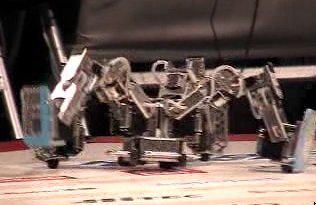
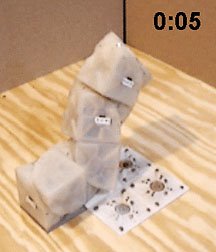
The Most Advanced Quadruped Robot on Earth
BigDog is the alpha male of the Boston Dynamics family of robots. It is a quadruped robot that walks, runs, and climbs on rough terrain and carries heavy loads. BigDog is powered by a gasoline engine that drives a hydraulic actuation system. BigDog's legs are articulated like an animal’s, and have compliant elements that absorb shock and recycle energy from one step to the next. BigDog is the size of a large dog or small mule, measuring 1 meter long, 0.7 meters tall and 75 kg weight.
BigDog has an on-board computer that controls locomotion, servos the legs and handles a wide variety of sensors. BigDog’s control system manages the dynamics of its behavior to keep it balanced, steer, navigate, and regulate energetics as conditions vary. Sensors for locomotion include joint position, joint force, ground contact, ground load, a laser gyroscope, and a stereo vision system. Other sensors focus on the internal state of BigDog, monitoring the hydraulic pressure, oil temperature, engine temperature, rpm, battery charge and others.
So far, BigDog has trotted at 3.3 mph, climbed a 35 degree slope and carried a 120 lb load.
BigDog is being developed by Boston Dynamics with help from Foster Miller, the Jet Propulsion Laboratory, and the Harvard University Concord Field Station.Development is funded by the DARPA Defense Sciences Office.
To watch a movie click here
|
[ReplieeQ2. via MouRa] | Hiroshi Ishiguro, who is the creator of the world's most human-like robot named ReplieeQ2 (a short video clip), is going forward with a seminal idea and hard work, some of which he may soon be able to delegate to an android of himself. "I will not need to come here again" "I will send my android instead" - according to The Sydney Morning Herald, that is what he said at at an international conference that recently took place in Sydney. In order to ensure his new android would resemble him as closely as possible, he was already covered from top to toe in a plaster cast and precise measurements of his skull were taken. He expects to finish building the android of himself within a few months. Last summer, Ishiguro gave a planery talk at a workshop, in which he talked about Android Science, a cross-interdisciplinary framework. |
His paper is available for download from the workshop website. Androids and other robots are different in the way they are evaluated -- because androids are expected to resemble humans as much as possible. There are a number of unique research challenges that need to be addressed for building better androids. And one could say that many of these challenges are related to the issue of anthropomorphism.
| Androids could also enable new methods for congnitive science research. Imagine an android version of Turing Test. Well, you can already do it with ReplieeQ2, I guess. Ishiguro discusses the issue of uncanny valley in relation to such a test. Uncanny valley corresponds to the state that androids imperfectly resemble humans and look like moving corpse. People will like them better if they look either more like humans or less like humans. I'm not an expert in this field, but it sounds like a key issues in this research. |
Again, what's particularly interesting is the mutually benefitting relationship of android engineering and cognitive science -- because androids could help advance cognitive science research, which will perhaps help build better androids.
related website:
Android Science (Ishiguro Lab at Osaka University)
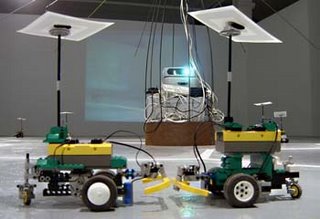
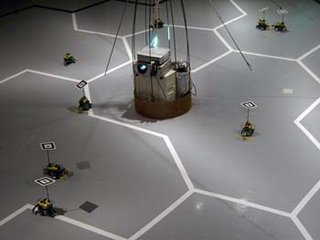
A first level features a community of small robots divided into two groups, the black one and the green one. Each group has a primary level of socialization and a series of sounds conforming a unique vocabulary. Each robot’s initial state consists of a very simple movement within a delimitated spatial environment. When it comes across other robots, it exchanges information about its state with sounds and increases its degree of socialization. Each increase implies a development in the complexity of movements.
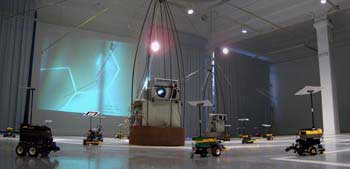
On a second level the users can participate with mobile phones and the Internet. They can connect to a program which communicates with the robots in real time and take influence on the state of sociability of each of the independent groups.
The installation consists of twenty robots, several cameras that record their movements in space and communicate the encounters that are generated to a social network system. These encounters are shown on a projector as a graphic display of crisscrossing lines. One of the robots is also equipped with a spy camera that represents one individual’s subjective point of view versus the graphic display of social statistics.
Made with Lego, the robots include also a programmable microprocessor, a chip to augment the possibilities to make different actions, and an infrared sensor to communicate. Two computers at the centre of the installation study the behaviour of the machines and send IR signals to modify the sociability of either the black or the green community.

Dylan Tinlun Chan builds delightful robot toys out of junk electronic components.

Jia-Yi-Bing is a series of three robots. Jia ("alpha") was originally created as a gift for a friend. Reluctant to give away the new robot, the designer cloned Jia to make Yi ("beta"). Then he made a third copy, Bing ("gamma"), as a dancing partner for Yi.
His portfolio includes also an extremely useful trio of robots that sits on top of a fan. When a robot is activated it plunges a needle into the spinning fan blade to create noises. Different robots produce different noises and together they form a kind of noise instrument.